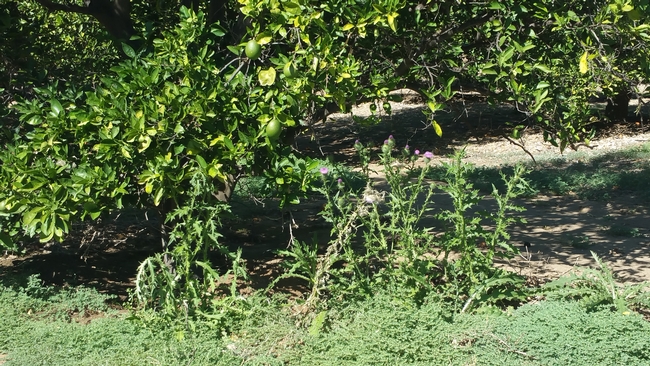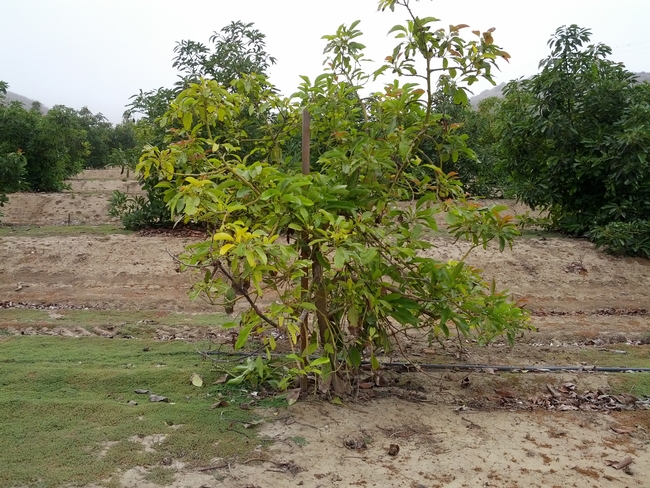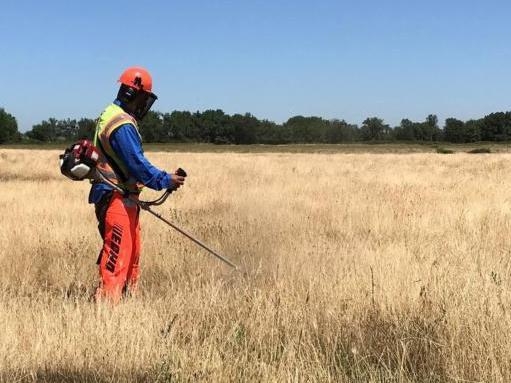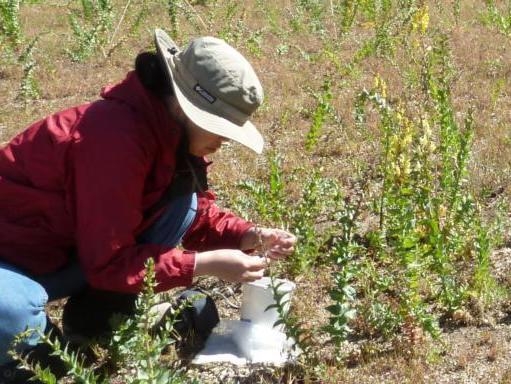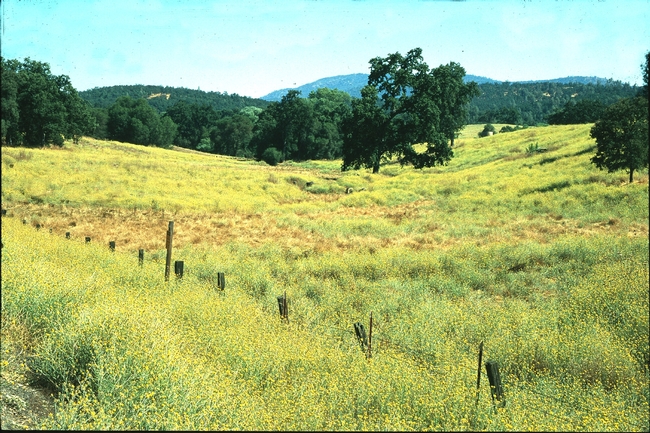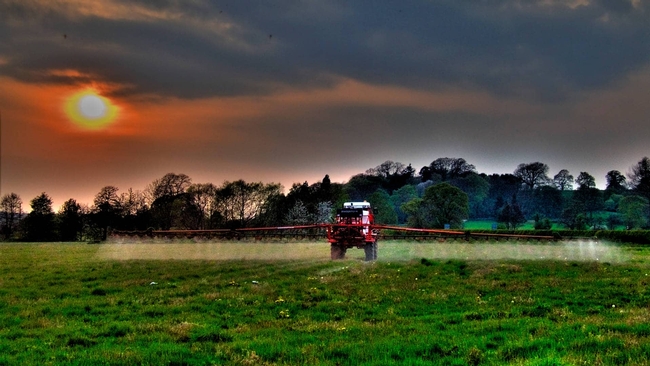Control of weeds has always been a major economic cost in subtropical fruit production because of favorable climate that allows for weed germination and year-round growth. The use of chemical weed control has increased dramatically due to labor costs, equipment costs, product costs and availability, the shift to more narrowly spaced tree rows, and installation of low volume irrigation systems that prohibit the operation of mowing or tillage equipment under the tree canopy area (Futch 2001).
However finding herbicides that are labeled for certain subtropical crops can be a bigger challenge. UC Weed Science has updated the Subtropical Crops herbicides usage chart for California growers (2020). It also seems that preventive programs are most frequently overlooked as a method of weed control. Preventive programs entail the use of such practices as sanitation, spot spraying, or hand labor to prevent the source of weed infestation (seed and/or vegetative) from widespread dissemination throughout a given area. By removing the undesirable weed species prior to seed development, dissemination by wind or mechanical transport on equipment can be effectively delayed.
Weed control programs will vary from location to location within the state and can even vary within a given site based upon specific conditions such as soil type, variety, method of herbicide application, and the presence of specific weed species.
Before herbicide application, growers should survey the grove and determine the stage of growth and type of weeds for that given location. Many products do not provide control of emerged species, thus requiring the application of more than one product to provide both preemergence and postemergence protection. Rotation of soil-applied herbicides should also be considered to prevent the buildup of resistant annual and perennial weeds. The resistant species may not be evident initially; however, if the same herbicide and cultural program is maintained, over time their populations may build up until they infest the entire grove and become the dominant weed species.
Herbicide damage to foliage and fruit has also been noted when herbicides were applied under windy conditions or use of improper equipment allowed the materials to contact areas other than the weeds or soil. Please make sure to follow the label's direction and use caution.
Attached is a chart listing herbicides registered for avocado, citrus, date, kiwi, fig and pomegranate, along with the Big Trees' herbicides. Check out how many more are available on almond than avocado. Both start with an A.
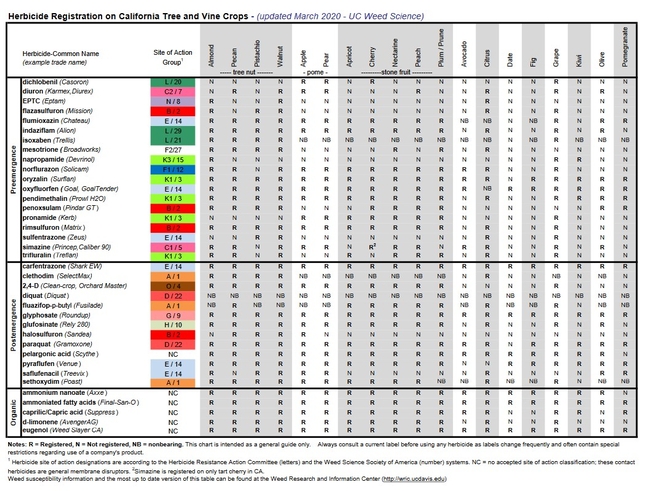
herbicides on trees 2020
Posted on
Friday, October 21, 2022 at
7:17 AM
Focus Area Tags: Agriculture
New online course on diagnosing herbicide injury now available
—Petr Kosina, UC Statewide IPM Program
A brand-new online course on Diagnosing Herbicide Injury focusing on how an herbicide injury situation can arise, what information can help diagnose symptoms during field investigations, and what tools are available to you, is now available from the UC Statewide Integrated Pest Management program (UC IPM).
When unexplained damage is noticed on a crop or other non-weed plant, herbicides are often a primary suspect. That is no surprise because herbicides are very powerful and effective tools used to control weedy plants in a wide variety of locations. However, symptoms of many other plant stresses, such as diseases and nutrient deficiencies or toxicities, can closely resemble the injury symptoms caused by herbicides. Economic implications of herbicide damage can vary–in some cases visible injury may have very little direct economic effect while in others, even slight herbicide symptoms can affect the marketability of affected plants. In addition, the presence of an unregistered herbicide on non-target crops can result in illegal residues which could have both safety and legal consequences.
The new online course was developed by Dr. Brad Hanson and Dr. Kassim Al-Khatib from the Department of Plant Sciences at UC Davis, and UC IPM instructional designers. If you are a grower, pest control adviser, or pesticide applicator, then this course is a great opportunity to learn about how to approach crop injury investigation when herbicide is suspected cause. You will learn how herbicides injure plants, how long herbicide symptoms may last and factors that may influence the time that herbicide injury symptoms are visible, possible scenarios of herbicide exposure based on uniform and variable injury patterns observed in the field, how to prepare samples for the laboratory analysis and more.
The course content is free to anyone who wishes to view it. For those requiring a certificate of completion and continuing education units (CEUs), the regular cost is $30, but we are offering a reduced price of $15 through October 31, 2021. Diagnosing Herbicide Injury course has been approved by the California Department of Pesticide Regulation (DPR) for 1.5 continuing education units (CEU) of Other, Certified Crop Advisor (CCA) for 1.5 units (IPM), and the Arizona Department of Agriculture for 1.0 Credit.
If you are a DPR license or certificate holder with a last name beginning with letters M through Z, then this will be your year to renew. Now is a good time to check out the other UC IPM online training courses offered. All are 50% off the regular price through October 31st. DPR strongly suggests returning renewal packets back to them by October so that your license or certificate can be renewed before it expires. Many of our courses are accredited by DPR for continuing education hours and also by the California Structural Pest Control Board (SPCB), Certified Crop Advisor (CCA), the Western Chapter of the International Society of Arboriculture (WCISA), and the Arizona Department of Agriculture.
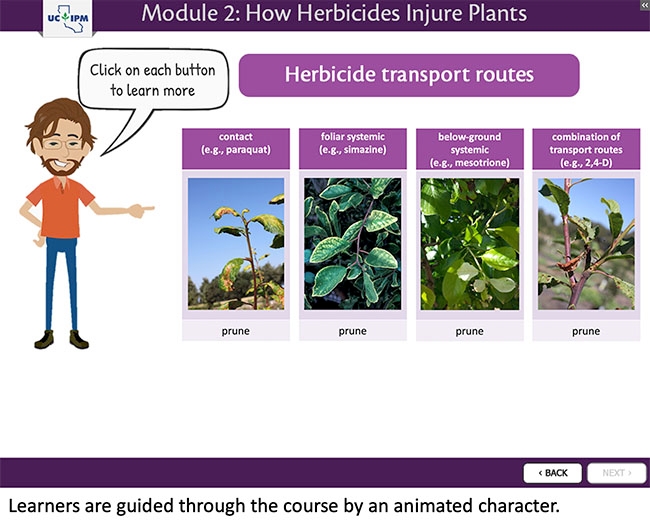
IPM character guiding course
Posted on
Monday, October 18, 2021 at
8:16 AM
Focus Area Tags: Agriculture
California has abundant wildlands — forests, rangeland, open areas, wildlife refuges and national, state, and local parks — that need protection from invasive plants. Invasive plants affect all Californians by increasing wildfire potential; reducing water resources; accelerating erosion and flooding; threatening wildlife; degrading range, crop and timberland; and diminishing outdoor recreation opportunities. According to the California Invasive Plant Council (Cal-IPC), more than 200 identified plant species harm California's wildlands.
Cal-IPC and the University of California Statewide Integrated Pest Management Program (UC IPM), with funding from the California Department of Pesticide Regulation (DPR) Alliance Grants Program, developed two resources that provide land managers access to the latest information on non-herbicide practices for managing weeds in wildlands. Best Management Practices for Non-Chemical Weed Control is a free downloadable manual. The same information has been incorporated into an interactive online tool called WeedCUT (Weed Control User Tool: weedcut.ipm.ucanr.edu).
"We anticipate WeedCUT will increase the use of more mechanical, physical, or biological practices, and potentially result in the reduction of herbicides used to manage wildland invasive weeds," said area IPM advisor emeritus Cheryl Wilen. "Best Management Practices for Non-Chemical Weed Control and WeedCUT were developed so land managers can become more knowledgeable and skilled in the use of non-herbicide methods as part of an IPM program.”
Knapweed control with a brush cutter. (Photo: Dawn Cunningham)
Best Management Practices for Non-Chemical Weed Control provides comprehensive descriptions of 21 commonly used non-herbicide weed control techniques and biological control agents for 18 invasive plants. Each chapter is the synthesis of research and on-the-ground knowledge from practitioners about non-herbicide methods. The chapters describe how a technique is best applied, the types of invasive plants and environmental conditions where it is most effective, and what its shortfalls might be. Environmental, cultural, and human safety risks are highlighted to help support the safe and effective use of these methods.
WeedCUT is the online version and can be used to learn about the different non-herbicide management methods, including the section on biological control. To filter through the database and learn which management practice to consider for a particular site and invasive plant type, a simple interface allows users to pick characteristics that describe their site and invasive plant problem. The tool then filters through the database to display the practices ranked by efficacy (excellent, good, fair, poor or ineffective). As in the manual, use of the technique and potential hazards are covered.
Best Management Practices for Non-Chemical Weed Control and WeedCUT are designed to be the go-to resources for practitioners that complement their conventional weed management work with non-herbicide techniques or are restricted in their use of herbicides. Both resources will help practitioners manage weeds more effectively.
Person releasing weevils for the biological control of Dalmatian toadflax. (Photo: Lincoln Smith USDA-ARS)
“Many experts in the field have contributed to create the manual and WeedCUT. It has been exciting to see these techniques described and reviewed so carefully. We're looking forward to seeing land managers, as well as all folks fighting weeds, incorporating the information from the manual and WeedCUT into their work,” said Jutta Burger, science program director and project lead with Cal-IPC.
While the manual and tool focus on non-herbicide methods, the hope is future funding can be found to continue the work and integrate herbicide options online.
"Land managers typically use both herbicide and non-herbicide methods, alone and in combination, to manage invasive plants in wildlands," said UC Cooperative Extension advisor and UC IPM-affiliated advisor Tom Getts. "A tool that combined both herbicide and non-herbicide methods would guide land managers to determine the most effective overall management program for their particular site."
Yellow starthistle is an invasive rangeland weed. (Photo: J. M. DiTomaso)
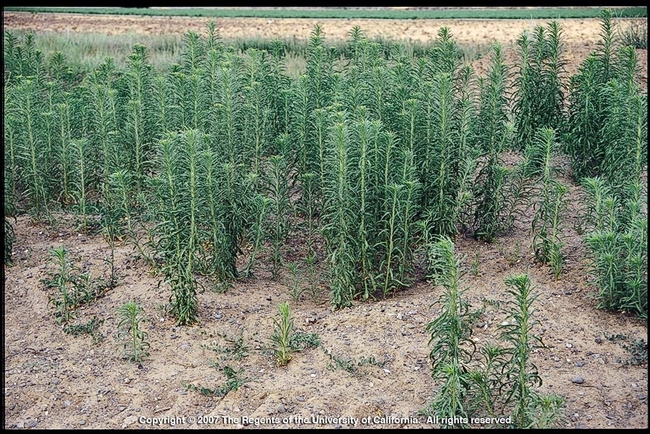
horseweed mature
Posted on
Wednesday, July 14, 2021 at
8:12 AM
- Author:
Tunyalee A. Martin, Jutta Burger, Cheryl A. Wilen, Thomas Getts
Focus Area Tags: Agriculture
Will Rising Temperatures Make Superweeds Even Stronger?
Widely used herbicides are struggling to kill some weeds. Some experts think heat could be part of the problem.
From the digital magazine, Undark • Dec. 7, 2020
By Natasha Gilbert • 12.07.2020
Around 10 years ago, in the fierce heat of the Kansas summer, many of the noxious kochia weeds invading Phillip Stahlman's research fields simply wouldn't budge when sprayed with a mixture of two widely used herbicides, glyphosate and dicamba. Just a few months earlier, in the cooler spring weather, the herbicide mixture had easily triggered the weed's small thin leaves to curl up and turn brown, signaling the plant's demise.
Now the stalwart weed had Stahlman stumped. Stahlman, then a weed scientist at Kansas State University, had never encountered this problem with herbicides before. He initially assumed that he had applied the agrichemicals incorrectly. But year after year, the same thing happened. Stahlman knew something was up. He kept a close watch on the weeds in his fields. He also conferred with local farmers who reported seeing similar problems. “The light didn't come on for a while until the issue kept reoccurring. It was like putting together a puzzle,” says Stahlman.
Eventually, Stahlman, who has since retired, decided that the problem was likely temperature: Something about spraying in high heat was rendering the herbicides less effective.
Stahlman is not alone in making this observation. Today, mounting evidence suggests that temperatures of around 90 degrees Fahrenheit or above can make some herbicide-resistant weeds even more resistant, and cause other weeds to be less sensitive to certain chemicals.
Some farmers say they know high temperatures can mess with some herbicides, so they try to avoid spraying in the heat of the day. “A good rule of thumb is if it's 85 to 90 degrees Fahrenheit, just don't spray,” says Curt Gottschalk, a farm manager in Hays, Kansas.
Not all experts agree that this pattern, largely demonstrated in lab experiments, poses a problem for farmers. And some herbicides appear to work even better at high temperatures. But if heat is boosting many weeds' resistance to major herbicides, the implications could be significant. Left unchecked, weeds can devastate harvests and income — if farmers didn't make an effort to control weeds, they could wipe out around half of all corn and soybean yields across the U.S and Canada, according to the Weed Science Society of America, a nonprofit society of academic and industry scientists. The loss could cost farmers around $43 billion annually.
Farmers are already battling against epidemics of weeds that have developed genetic resistance to multiple herbicides, including glyphosate and dicamba. Stahlman and other weed researchers argue that temperature could be an overlooked second factor strengthening weeds' defenses against herbicides. Although most farmers now understand that temperature affects herbicides, to the untrained eye it could look just like herbicide resistance, Stahlman says.
These researchers also fear the issue could worsen in the future as climate change raises temperatures and extreme weather events, including heat waves, become more frequent.
“We already know that herbicide resistance is the most problematic issue in chemical weed control,” Maor Matzrafi, a weed scientist at Israel's national Agricultural Research Organization, wrote in an email to Undark. “Maybe reduced sensitivity due to climate change is next in line.”
Farmers used to rely less on herbicides, instead controlling weeds using laborious methods such as tilling and manual removal. But, starting in the mid-1990s, biotechnology companies began debuting genetically modified crops that were resistant to common, powerful herbicides. The new seeds allowed farmers to liberally spray their fields with agrochemicals to kill weeds while their GM crop flourished. The technology made most manual weeding unnecessary, and herbicide use surged globally. But weeds evolved in response, and herbicide resistant varieties emerged. That has set off a new battle between farmers and weeds, with farmers increasingly using combinations of chemicals, as well as additional doses, to try to knock off weeds.
After Stahlman's experience with kochia weeds, though, he began to examine whether temperature could be affecting herbicide performance more than was widely recognized. (Stahlman, like many academic weed scientists, has received research funding from agrochemical companies in the past.)
To decipher how heat helps weeds fend off herbicides, Stahlman teamed up with KSU colleagues Mithila Jugulam, a weed physiologist, and Junjun Ou, a research assistant. The team grew seedlings from kochia populations that originated in Kansas, in chambers kept at temperatures ranging from 63.5 to 90.5 degrees Fahrenheit — representative of the state's spring and summer daytime heat. The temperature in the chambers dropped every 12 hours to mimic cooler nighttimes. When the seedlings reached around 4 inches high, the researchers dosed some with glyphosate and others with dicamba. At weekly intervals, the team examined the weeds for signs of injury. After one month, they cut down the weeds and dried and weighed them.
The team found that, at high temperatures, they needed more than twice the amount of glyphosate and dicamba to control weeds. They published their results in 2016.
“A good rule of thumb is if it's 85 to 90 degrees Fahrenheit, just don't spray,” says Curt Gottschalk, a farm manager in Hays, Kansas.
To understand why heat reduced sensitivity, the researchers tracked the herbicides' paths through the weeds using mildly radioactive versions of glyphosate and dicamba. The former previously manufactured by Monsanto, and the latter produced by BASF Corp. (BASF Corp. provided a graduate student assistantship to Ou for a different project.)
The team found that the leaves absorbed less glyphosate at higher temperatures. They're not sure why, but Jugulam thinks the heat may encourage the kochia to develop thicker cuticles — a protective layer on the leaf surface — which then boost the weeds' defenses against the herbicide. The team discovered a different process at work when the weeds encountered dicamba. Temperature did not affect the amount of dicamba that the weeds' absorbed, but it did hinder the herbicide's movement through the plant so that less reached its target — the tissue developing at the tips of new shoots and leaves.
In another study, published last year, Jugulam turned her attention to the herbicide 2,4-D, one of the ingredients of agent orange, an infamous defoliant used in the Vietnam War. Today, it's one of the most widely used herbicides. Jugulam tested how temperature affected the herbicide's ability to control common waterhemp, a broadleaf weed found encroaching on Midwestern corn and soybean fields.
In the tests, Jugulam examined some common waterhemp that had developed genetic resistance to 2,4-D, and some that had not. She found that it took more than three time as much herbicide to kill the resistant weed under hot, dry conditions than at cooler temperatures. She found a similar but smaller effect in the susceptible weeds.
Herbicide-resistant waterhemp survives exposure to 2,4-D by quickly breaking the chemical down into nontoxic substances before it can reach its targets at the tips of roots, stems, and leaves. When the temperature is high, Jugulam found, waterhemp breaks down those molecules faster.
Jugulam also noted that under high temperatures, some herbicide resistant weeds appear to become more resistant and some susceptible weeds may require more herbicide for their control.
Not all weeds and herbicides respond to temperature the same way. For example, Jugulam has also found that 2,4-D and glyphosate work better at higher temperatures against common and giant ragweed, two other weeds common in U.S. farmers' fields. Jugulam also says that, even in cases where heat does hinder herbicides, the impacts appear to be mostly limited to dry conditions. Areas with high humidity and rainfall might not see the same effects.
But some experts say evidence is growing in a variety of species and agrochemicals that temperature, and in some cases high carbon dioxide levels, affect weed control, at least in the laboratory.
In tests published in 2016, Matzrafi found that at high temperatures four different species of grass weeds stood up against diclofop-methyl, an ingredient in an herbicide manufactured by Bayer, significantly better than they did at lower temperatures. Matzrafi also found that high temperatures made another herbicide, pinoxaden, less able to curb growth of the invasive grass false brome. Moreover, the grass thrived even when it was switched from cooler conditions to a hotter environment up to two days after the herbicide treatment.(The research was partially funded by ADAMA Agricultural Solutions, an agrochemical company based in Israel.)
“Our findings, and many other studies since the ‘90s, suggest that post-application environmental conditions may also affect herbicide sensitivity,” explained Matzrafi in an email. Even if farmers spray during cooler temperatures, that might not be enough to avoid the effects of heat.
Those conditions, experts fear, will worsen under climate change. Already, many U.S. states important for agriculture, as well as other major food producing regions around the world, regularly experience temperatures topping 90 degrees Fahrenheit during growing seasons. Some researchers say that problems with heat and herbicide performance are coming to the fore now partly because of more frequent episodes of extreme heat over the past few decades.
However, it is hard to pin the effects seen today on recent climatic changes, Lewis Ziska, a plant physiologist at Columbia University in New York, wrote in an email to Undark. But, noting that weeds are “the greatest constraint for food production,” Ziska warns that “they will be a formidable challenge for farmers in a more extreme environment.”
In the Midwest, for example, temperatures could rise by an average of 8.5 degrees Fahrenheit by the end of the century, with longer and more frequent stretches of extreme heat, according to federal government projections. And in South Asia, including India — a globally important region for producing rice, pulses, nuts, and cotton — the Intergovernmental Panel on Climate Change projects that average annual temperatures will rise by nearly 6 degrees Fahrenheit by 2100.
In the first experiment of its kind, the results of which were reported last year, Matzrafi studied the joint effect of heat and raised carbon dioxide levels on two different weed species and found that the combination boosts weeds' herbicide defenses beyond that by either factor alone.
It's not clear whether herbicide manufacturers are prepared for the coming challenges of a warming planet. Many do not recommend optimal spraying temperatures to ensure efficacy in the guidelines they distribute to farmers.
In a written statement Clark Ouzts, a spokesperson for Sygenta, the manufacturer of pinoxaden, says the company has not studied the potential effects of climate change on the herbicide's activity, but that “field research and commercial applications have not shown temperature to have a significant impact on the activity of Pinoxaden.”
Charla Lord, a spokesperson for Bayer, wrote in a statement that the company's herbicides are “extensively tested to meet all regulators' requirements” and “labeled so applicators know how to apply for them for optimal control and success.” The company did not respond to specific questions regarding the efficacy of their products under high temperatures, although the company has posted about the challenges of high-temperature spraying on its website.
Corteva, which makes herbicides incorporating 2,4-D, did not respond to requests for comment on how high temperatures affect the herbicide's performance.
Not everyone is convinced that these experimental findings spell trouble for farmers. Some researchers and weed experts say that laboratory conditions differ radically from the field, making the results less pertinent. “I don't think we could say for sure that this is having an impact at the real-world scale,” wrote Brad Hanson, a weed expert at the University of California, Davis, in an email to Undark. Hanson worked with Matzrafi on the research published last year.
Hanson, who works with California farmers as a researcher and extension specialist, also wrote that farmers typically use enough herbicide to overcome any small changes in weed sensitivity brought on by heat.
Kassim Al-Khatib, a crop physiologist at the University of California, Davis who has investigated how herbicides perform under heat and humidity, wrote in an email to Undark that the studies are carried out under carefully controlled laboratory conditions that farmers would never find in their fields.
“What happens under controlled conditions does not generally support what happens in field conditions,” he wrote.
It's not clear whether herbicide manufacturers are prepared for the coming challenges of a warming planet.
In his own research, Al-Khatib has studied the effect of temperature and humidity on a small number of herbicide types and weed species. In the cases he has studied, he says, herbicide efficacy generally improves at higher temperature and humidity, unless temperatures exceed 100 degrees Fahrenheit.
Matzrafi and Jugulam agree that the lab does not reflect the more complex farm environment.
“But I don't think it lessens the importance of the results,” Matzrafi wrote. He, Stahlman, and others say they have seen the effect in the field for themselves.
“I think we are seeing something. Over the next 10 years I think we will see more. It's going to be a major problem,” says Chuck Otte, a K-State Research and Extension agent in Geary County, Kansas, who primarily works with farmers.
The research findings are trying news for farmers who rely on herbicides to keep increasingly weaponized weeds at bay. For now, some farmers are striving to stave off some of the effects from heat by spraying herbicides during cooler periods of the day. In the heart of summer, Carie Moore says she sometimes wakes before dawn to spray her 650-acre farm in North Dakota before the heat climbs too high, occasionally topping 100 degrees Fahrenheit. But as the globe warms, farmers will face narrower windows during which temperatures are cool enough to spray, says Ziska. And Matzrafi's research suggests that spraying during cooler periods doesn't guarantee that herbicide efficacy isn't affected by bursts of heat that come later in the day or even the following day.
And sometimes farmers can't avoid spraying herbicides in the heat, particularly on huge farms with several thousand acres.
Otte says that skeptics might not realize their herbicides are not working because heat has given weeds a helping hand. They might first assume that an array of other common factors are at fault, such as herbicide resistance, lack of rainfall, or too little herbicide. “There are so many confounding factors it is difficult to sort it all out,” he says.
In the long-run, farmers will need to lessen their reliance on herbicides and instead use other techniques more often used in organic farming today to keep weeds at bay, many experts say. For example, planting cover crops such as spring oats or crimson clover helps stop weeds taking root in bare soil and growing a variety of crops in rotation can wrong-foot weeds helping to suppress populations. Moore is already moving in this direction. She rotates soybeans with wheat, barley, and a couple of other crops and plants a variety of additional cover crops including rye and peas.
She also occasionally tills the soil to help stifle weed growth. “The less we have to spray chemicals the better,” she says.
Yet, to keep up yields, farming can't entirely abandon herbicides, says Ziska. With very few new chemicals on offer, farmers will need to be more careful with the herbicides they have now to ensure they continue to work in the future. Manufacturers need to provide farmers with better advice on when and how to use herbicides, adds Matzrafi.
“Farmers can no longer just spray and pray,” says Otte.
***
Natasha Gilbert is a freelance reporter in Washington, D.C., who has spent over a decade covering the environment, agriculture, and sustainability.
Original source: Undark • Dec. 7, 2020
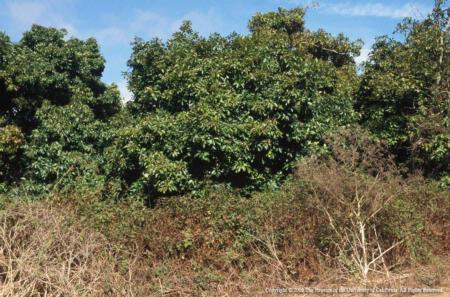
weeds bordering avocado orchard
Posted on
Wednesday, January 27, 2021 at
7:44 AM
Focus Area Tags: Agriculture
Department of Botany and Plant Sciences, UC Riverside
Proper weed management is important for several reason, but in general younger orchards are much more susceptible to the negative impacts of weed overgrowth. The full canopies of mature orchards limit the amount of sunlight reaching the orchard floor, which suppresses the growth of many weed species. Younger trees also have less extensive rooting systems, putting them into direct competition with weeds for water and nutrients. The presence of weeds provides habitat for insects, pathogens, and rodents, which can affect trees of all ages through direct damage to vascular tissue and foliage, and as disease vectors. Rank growth of weeds also visually obscures irrigation infrastructure and signage, and in some cases even field roads. Weeds can also limit mobility of laborers during harvest, and snag on ladders, which is a safety hazard for workers. Frost damage is more likely in orchards with weed overgrowth because there is less transfer of heat from the sun to the soil surface and lowers the amount of heat that will radiate back into the air during the night. Further, weeds are a primary source of fuel for fires. Weed management can be broken down into four phases that correspond to different life stages of the citrus orchard: 1) best practices before the trees go in the ground, 2) best practices for young orchards, 3) best practices for established orchards, and 4) monitoring or scouting which is ongoing throughout the life of the orchard. Each of these phases or scenarios has a different set of challenges and somewhat distinct set of management opportunities and constraints.
Monitoring is critical in identifying how effective management practices are, is helpful in identifying what practices may be having unintended consequences (increasing a particularly problematic weed species for example), and provides clues for what can be done differently to achieve more satisfactory results. The first step in effective management is to know what weed species are present, their relative abundance, and where they're located (more on weed id later). This is important because different weed species have different tolerances and susceptibilities to herbicides and other control methods, and knowing where they appear in an orchard in a given year is a good predictor of where they may occur in the future. Keeping accurate records of weed species and locations and reviewing these records periodically will facilitate an adaptive approach when combined with knowledge of past management practices. Under irrigated conditions, weeds can and do germinate, grow, flower, and set seed all year long, but generally the biggest flushes of weed population growth are in the cooler months and warmer months. This is when they will be easiest to detect. However, it is worth noting that this is not necessarily the best time for management – all too often by the time they are noticed, they've reproduced, and in the case of annuals it's too late for control (annuals will die no matter if you kill them or not – what's important is to stop them from setting seed). The University of California Statewide Integrated Pest Management Program (UC IPM) offers some useful monitoring forms available online. These forms contain a section to sketch out the locations of weed species, infrastructure, and other landmarks within an orchard, and are already partially filled in with common weed species by season (summer vs. winter). Pay particular attention for the weeds that are most difficult to control: namely perennials (Johnsongrass, bermudagrass, nutsedge, bindweed, etc.) and species with known herbicide resistant populations in California (horseweed, fleabane, Palmer amaranth, junglerice, etc.). Also, limit monitoring to the orchard itself- weed propagule pressure can and will come from off-site, especially from roads and adjacent areas that aren't are not actively managed.
Weed management before planting is the best opportunity to reduce the overall weed seedbank, but more critically it is when the most effective management options are available to remove perennial weed species from the site. In the case of perennials this is also the most economically efficient opportunity for management as any perennial weeds left in place may incur management costs for the life of the orchard for ongoing suppression instead of a one-time cost for removal. This is one of the few times that cultivation won't have negative impacts on crop health and productivity. A useful strategy for perennials with underground storage structures is to repeatedly disc the field every few weeks to bring the roots to the surface and allow them to desiccate in the hot sun (this should take place during the summer months). For an integrated approach, supplement this strategy with a systemic postemergence herbicide, applied in the fall when the plants are preparing for dormancy. This is when weeds will have maximum translocation rates of photosynthate (carbohydrates) from the leaves to the roots. Because systemic postemergence herbicides follow this same path within the plants, this is when the weeds are most susceptible to complete kill from these herbicides. This can be repeated in the spring for regrowth and followed by discing 2-3 weeks later to again expose and dehydrate rhizomes. Once irrigation infrastructure is in place, another strategy is to irrigate to “flush” the weed seedbank. For annual species a burndown herbicide application can be used to kill emerging weeds – important to time this properly to catch the two main cohorts of annuals (cool- and warm-season germinators), so plan to repeat at least twice in one year. For perennials a systemic postemergence herbicide may work better, especially if they are not sprayed very soon after emergence when they are susceptible to contact herbicides. Repeat multiple times to greatly reduce weed seed load on site and minimize future management requirements. Additionally, properly timed preemergence applications can further deplete the weed seedbank by killing plants as they germinate in the spring or late summer/early fall. Any weeds that survive should be spot-treated with herbicide or hand rogued.
Once young trees are in the ground, it's important to minimize root disturbance, especially close to the trunks of the trees. This means more reliance on chemical control, but also keep in mind that the trees are also more susceptible to injury from herbicides at this stage from roots and foliage. The bark is also less lignified and herbicide is more easily taken up through this route than on older trees. Protect with wrappers and/or use a spray shield when applying herbicide to minimize potential damage from drift. Because roots are more sensitive to herbicide uptake it is important to select preemergence herbicide products that are labeled as safe for young trees. Postemergence herbicide options are 1) contact herbicides (includes all of the organic products), 2) systemic herbicides that are selective for grass species, and 3) glyphosate. Contact herbicides are only effective when applied to young plants below a certain height (this varies by product so refer to the label, but always better to catch them sooner than later), and are less effective on perennials than annuals. Grass herbicides, although systemic, are most effective on annual grasses, but will kill certain perennial grass seedlings below 4-6 inches in height.
Cultivation should be avoided whenever possible. Several studies demonstrate the negative impact of cultivation in citrus. These include but are not limited to damage to feeder roots, which impacts the trees ability to collect soil resources (nutrients, water, oxygen); increasing exposure to soil pathogens which can enter the vascular system of the tree through damaged tissue; and increased risk of soil erosion, especially in sloped orchards. Further, the additional passes with a tractor can contribute to compaction, especially in finer textured soils, which limits tree root growth and ability to uptake soil resources. Dust generated from cultivation practices can reduce the effectiveness of biocontrol of insects and mites, and also buries organic matter in the soil, providing a food source for certain insect pests. Cultivation also risks spreading root fragments of perennial weed species throughout the field and making weed problems worse.
A robust preemergence herbicide program can be helpful in managing orchard weeds, but preemergence herbicide efficacy and safety can be greatly modulated by several factors. Finer soil texture can bind up certain herbicides, making them less effective. Herbicides can quickly move beyond zone of seed germination in coarse soils, also making them less effective. Soil pH, especially in CA, can be high (alkaline) when calcium carbonate (aka caliche) is present in the soil, causing increased carryover or herbicide persistence and potential for injury. Knowledge of orchard soil characteristics and a careful review of the herbicide product label are critical in avoiding unintended crop injury. Many product labels will contain special precautions or rate modifications for specific soil characteristics or weather conditions. Herbicides are also broken down by sunlight on the soil surface if not immediately incorporated via rainfall or irrigation. Under prolonged moist soil conditions, certain herbicides are more quickly broken down by soil microbes, and are also moved out of the zone of seed germination. If permitted by the product label (limited by recommended application rate, max rate per year ,and pre harvest interval), sequential applications can be made to extend control.
Contact herbicides are not translocated within the weed's vascular system, they require more complete coverage as they only kill the parts they come in direct contact with. This is less of an issue for annuals (always attempt to target annuals before they set seed) but a drawback of contact herbicides is that they are much less effective at controlling perennial weeds unless applied to newly emerged seedlings. Suppression of perennials (not mortality) will likely require multiple applications of a contact herbicide. A positive aspect of contact herbicides is that their efficacy may be less affected by drought conditions than systemic herbicides.
There are few systemic postemergence herbicide products labeled for citrus. Systemic (translocating) postemergence herbicides don't require as complete coverage as contact herbicides, but they do require active growth and are highly impacted by drought. As always, young, succulent plants are more easily controlled than mature plants with waxy leaf cuticles that impede absorption. For many reasons, glyphosate usage may be restricted in some areas or situations. This is problematic because glyphosate is the only postemergence herbicide option for labeled for control of most perennial weed species in California citrus, especially broadleaves weeds (but many grass species as well). When glyphosate is not available, thorough weed management prior to planting and robust preemergence herbicide programs are even more critical to successful and effective weed management. Other postemergence weed management options include mowing (although this tends to select for more perennial weeds) and hand roguing which can be expensive when weed problems are extensive. Cover crops are another potential option, but more research is needed to help identify appropriate cover crop species, recommended cultural practices for their management in citrus orchards, and their potential positive and negative impacts on orchard productivity.
The first category of problematic weeds in citrus are those species that have known herbicide-resistant populations. This topic is covered more thoroughly in other UC publications, but for the purposes of citrus weed management the three main species of concern are horseweed (Erigeron canadensis), fleabane (Erigeron bonariensis), and Palmer amaranth (Amaranthus palmeri). These species are known to have populations in California with glyphosate resistance. To manage these species 1) use herbicides with multiple modes of action, 2) use full label rate of glyphosate (no “burndown” applications), 3) treat when small, and 4) avoid incomplete control of the targeted population and adjacent populations (ditchbanks, roadsides, etc.).
The second category of problematic weed species are those with tubers, rhizomes, and/or a long-lived seedbank such as nutsedge and Johnsongrass (Sorghum halepense). Yellow nutsedge (Cyperus esculentus) is found throughout California to 3300 ft in elevation. It produces round, smooth tubers about ½ inch in diameter that are usually found in the upper 6 inches of soil, but sometimes much deeper (particularly if buried during cultivation). Yellow nutsedge tubers are only found at the ends of the rhizomes. Purple nutsedge (Cyperus rotundus) is found mostly in the southern parts of California (Central Valley, South Coast, and Desert to 820 ft in elevation). Tubers are larger than those of yellow nutsedge (about 1 inch), oblong, rough, and scaly, and are chained together at the ends of the rhizomes. Nutsedge is best controlled by eliminating it from the site before planting the orchard (as described earlier), and past this time can be extremely difficult to manage. Young plants can be controlled with glyphosate, but once plants develop more than 5-6 leaves (often called the “FLS” or “five leaf stage”) translocation of carbohydrate from the leaves to the tubers is limited, meaning that only top-kill occurs. Further, yellow and purple nutsedge also do not typically reproduce from seed, meaning that preemergence herbicides are not very effective. Some sulfonyl urea preemergence herbicide products labeled for citrus are effective at controlling nutsedge when applied foliarly (postemergence), though repeated applications are likely necessary for more complete control. Nutsedge tends to dislike shade and is less of a problem once orchards are established and canopies are mature.
Johnsongrass is a rhizomatous perennial grass species with very long-lived seeds that can remain viable in the soil for more than 5 years. Like nutsedge, Johnsongrass is best to control before orchard is planted so that repeated tillage can be utilized that bring rhizomes to the soil surface where they will desiccate and die. This should be done in the summer when the soil is dry. Keep in mind that Johnsongrass can form plants from rhizomes as small as 1 inch long, so cultivation under moist conditions can exacerbate the problem by spreading rhizomes throughout the orchard. Otherwise glyphosate, specifically timed for immediately after plants finish flowering in August and September may be the best control option. This is when the plant will be moving photosynthate into the rhizomes and the herbicide will be more efficiently transported to this structure where it can kill the plant.
The UC Statewide IPM Program has several online resources available for integrated management of weeds in citrus. These include a photo gallery of common citrus weeds to aid in identification, a tutorial on how to identify weed species from common morphological traits (complete with illustrations), a chart of herbicide susceptibility by weed species, and a searchable gallery of herbicide injury photos.
Monitoring forms: http://ipm.ucanr.edu/PMG/C107/citrus-summerweeds.pdf
http://ipm.ucanr.edu/PMG/C107/citrus-winterweeds.pdf
Weed ID and photo gallery: http://ipm.ucanr.edu/PMG/weeds_intro.html
Weed species herbicide susceptibility: http://ipm.ucanr.edu/PMG/r107700311.html
Herbicide symptoms: http://herbicidesymptoms.ipm.ucanr.edu/
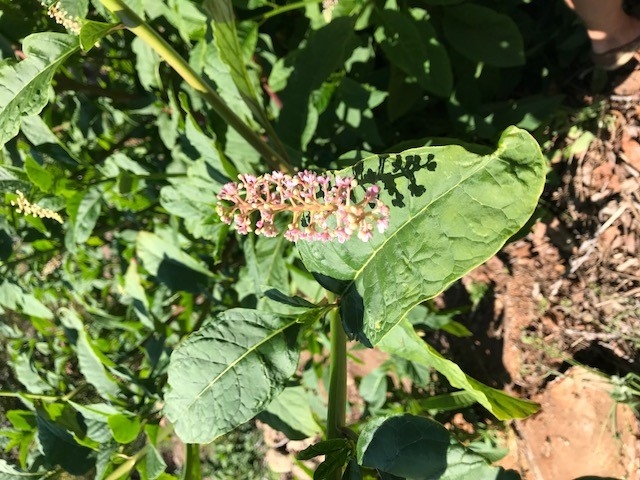
weed 1
Posted on
Friday, January 10, 2020 at
7:27 AM
Focus Area Tags: Agriculture


